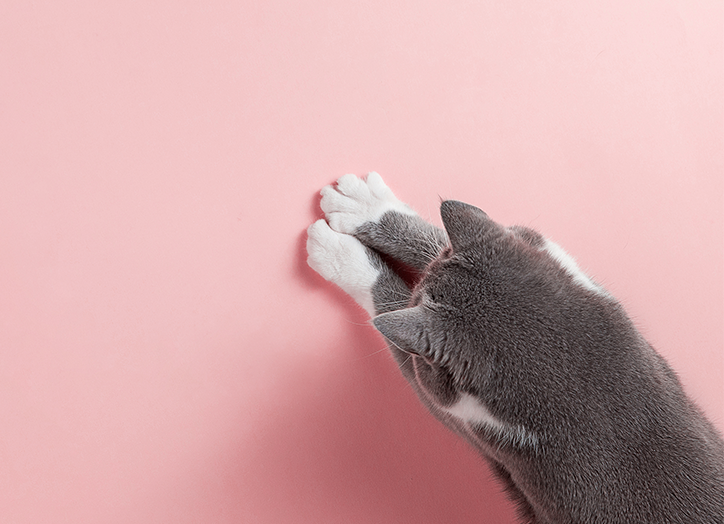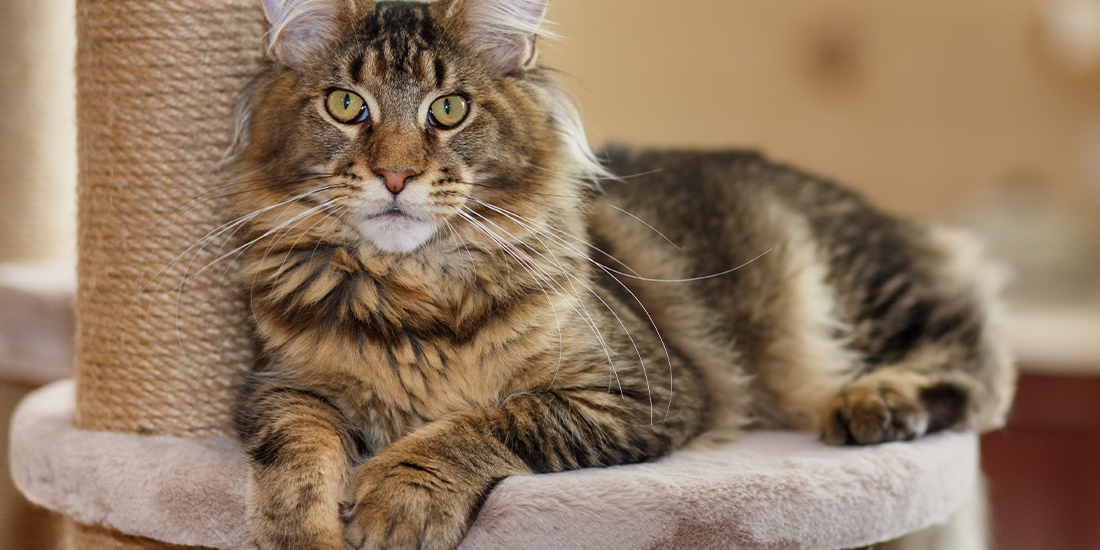[vc_row][vc_column][vc_column_text css=””]
As responsible pet owners, ensuring the well-being of our feline friends involves various aspects, and one crucial element is maintaining a healthy weight. Just like humans, cats can face health issues if they are underweight or overweight. In this comprehensive guide, we will delve into what constitutes a healthy weight for a cat and provide valuable healthy cat weight management tips.
[/vc_column_text][/vc_column][/vc_row][vc_row][vc_column][vc_row_inner content_placement=”middle”][vc_column_inner width=”1/2″][vc_column_text css=””]
How to tell if your cat is a healthy weight?
Consult your veterinarian
Before embarking on any weight management journey for your cat or trying to find a healthy weight for cats, it’s essential to consult your veterinarian. A professional assessment will consider your cat’s breed, age, overall health, and lifestyle to determine an appropriate healthy cat weight range.
Body Condition Score (BCS)
Like humans have a Body Mass Index (BMI) to identify our ideal weight, our pets have one, too. A Body Condition Score (BCS) is a helpful tool for assessing a healthy cat weight. VCA says that two recognized BCS scales are utilized, one ranging from 1-5 and the other from 1-9. Some veterinarians prefer the 1-9 scale, which has more freedom to identify subtle changes in weight. Whichever scale you use, it’s best to reference the highest number. For example, a pet with a BCS of 5 would be obese on the 5-point scale (5/5) and ideal healthy cat weight on the 9-point scale (5/9). A pet with a BCS of 3 would be the ideal healthy cat weight on the 5-point scale (3/5) and thin on the 9-point scale (3/9).
A cat at a healthy weight should have a well-proportioned body, easily palpable ribs, and a discernible waist.[/vc_column_text][/vc_column_inner][/vc_row_inner][vc_row_inner][vc_column_inner width=”1/2″][vc_column_text css=””]
A look from above
Another way to check their weight is by going from a different perspective. Cumberland Animal Clinic says you can look down at your cat from directly above while he or she is standing. Look for a small indent above your cat’s hips, where their waist should be (this can be a bit tricky with long-haired cats). If you can’t see their waist or their sides are bulging, there’s a very good chance that your cat is overweight.
Breed specifics
Certain cat breeds may have different ideal weight ranges. Larger breeds like Maine Coons may naturally weigh more than smaller breeds like Siamese. Understanding breed-specific characteristics is crucial in setting realistic weight goals.[/vc_column_text][/vc_column_inner][vc_column_inner width=”1/2″][vc_column_text css=””]

What is a healthy weight for a male cat and what is a healthy weight for a female cat?
Whether they’re male or female, Petmd says that the ideal healthy weight for a cat is 8-12 pounds. With that said, a healthy weight is subject to change based on a cat’s frame and size.[/vc_column_text][/vc_column_inner][/vc_row_inner][vc_row_inner content_placement=”middle”][vc_column_inner width=”1/2″][vc_column_text css=””]
The risks of underweight and overweight cats
When exploring a healthy cat weight, you’ll want to understand the risks of being over and underweight first!
Underweight cats
Underweight cats may suffer from malnutrition and a weakened immune system. Causes include illness, malabsorption issues, or inadequate nutrition. A proper diet, often recommended by a veterinarian, can help address these concerns.
Overweight cats
These are weights that far exceed a healthy cat weight. Obesity in cats is a prevalent issue that can lead to severe health problems, including diabetes, arthritis, and cardiovascular diseases. Overfeeding, lack of exercise, and poor dietary choices are common contributors to obesity.[/vc_column_text][/vc_column_inner][vc_column_inner width=”1/2″][vc_column_text css=””]

Cat weight management tips
Weekly weigh-ins
Do a weekly weigh-in with your cat to ensure they are maintaining a healthy body condition.
Portion control
Avoid free-feeding and establish a consistent feeding schedule with measured portions. This helps prevent overeating and ensures your cat receives the necessary nutrients without excess calories. A Bold by Nature raw cat food diet is served in patties, making portioning easy and efficient.
Regular exercise
Engaging your cat in regular play and exercise is vital for weight management. Provide toys that encourage physical activity, and dedicate time each day to interactive play sessions.
Monitor treats
While treats can be a great way to bond with your cat, excessive treats contribute to weight gain. Opt for low-calorie treats and limit their frequency to maintain a cat healthy weight.[/vc_column_text][/vc_column_inner][/vc_row_inner][vc_row_inner content_placement=”middle”][vc_column_inner width=”1/2″][vc_column_text css=””]
Weight loss programs
Your veterinarian may recommend a structured weight loss program if your cat is overweight. This may include a specific diet, increased exercise, and regular progress evaluations.
Hydration
Ensure your cat has constant access to fresh water. Adequate hydration is crucial for overall health and can aid in cat healthy weight management.
Veterinary check-ups
Regular veterinary check-ups are essential for monitoring not only a healthy cat weight, but their overall health. Your vet can adjust the weight management plan as needed. This will also be a good way to keep an eye on their body condition.
Healthy nutrition
Choosing a high-quality cat food that aligns with your cat’s age, activity level, and health status is paramount. We recommend a Bold by Nature raw diet for cats, as they contain low levels of fat and carbs.[/vc_column_text][/vc_column_inner][vc_column_inner width=”1/2″][vc_column_text css=””]

What is considered good weight management cat food?
When trying to find a reliable weight management cat food, we recommend going raw! A Bold by Nature cat raw food diet contains beneficial nutrients for your cats to help them thrive. Feeding your cat raw food can help regulate their weight, and it may even help them lose weight if they are overweight. These diets are light on ingredients and heavy on the benefits!
Weight can also be heavily affected when your cat suffers from a health issue. For instance, cats with diabetes can experience appetite changes, causing them to sometimes eat less or much, much more. Our diets are also free of unnecessary fillers, meaning they help to promote excellent body condition and prevent obesity. Also, if you’re wondering what to feed a constipated cat or how to help with cat digestive issues, raw diets are an excellent option.
Just remember when determining a healthy weight for cats and switching their diet, you may want to check in with your holistic veterinarian first![/vc_column_text][/vc_column_inner][/vc_row_inner][vc_row_inner content_placement=”middle”][vc_column_inner width=”1/2″][vc_column_text css=””]
How much should you feed your cat?
When giving your cat a meal, you’ll want to feed based on their ideal weight, not their current weight. For example, if your cat is overweight at 12 lbs, but their ideal weight is 9 lbs, you would base their food intake on the 9 lbs.
All Feline Hospital says the average indoor cat should have 20 calories per pound to maintain weight. If your cat stays mainly outdoors, it should have an average of 35 calories per pound to maintain weight. Lastly, if your cat is a mix of Indoor/outdoor, its calorie intake will be somewhere in between.
How else can I get my cat to eat more?
If you don’t want to change your cat’s diet completely but still want to entice them to eat more, you’ve got a couple of options! Bold by Nature offers Bowl’d – a dehydrated gravy you can top your pet’s meal with. These delicious gravies are packed with flavour and some extra nutrition that your cat won’t be able to miss.
You can also try Bold by Nature+ supplements, like pumpkin powder for dogs or slippery elm. These easy-to-use supplements can help entice your cat to eat while providing a boost of goodness in every meal.[/vc_column_text][/vc_column_inner][vc_column_inner width=”1/2″][vc_column_text css=””]
Where Bold by Nature products be purchased?
Ready to buy raw cat food? You can purchase Bold by Nature raw pet food online or at a local retailer that carries our products! If you’re not sure if your local shop carries our products, you can use our handy location finder to find out.
[/vc_column_text][/vc_column][/vc_row]













